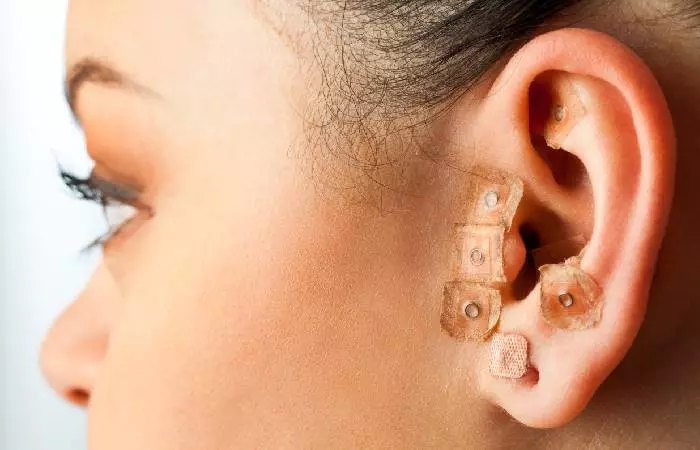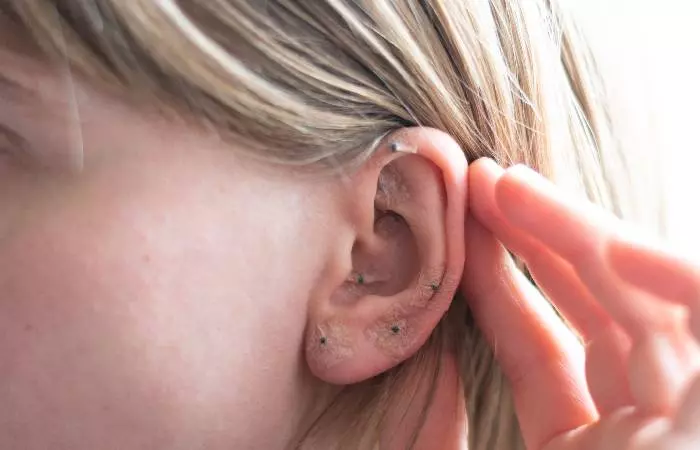Historical Background
Ear piercing acupuncture has a long history spanning across thousands of years. In ancient China, acupuncture techniques were developed to restore the flow of qi, or life energy, by stimulating strategic points on the body with needles. A specific form of acupuncture called auriculotherapy centers on piercing or applying pressure to points on the outer ear, seen as a microcosm of the whole body in traditional Chinese medicine. Ancient Egyptian and Indian cultures also intuitively practiced ear piercing at certain points or times for health benefits like improved eyesight, digestion in babies or chronic pain (1). Ancient texts like the ‘Karna Vedha’ suggest that auriculotherapy aimed to improve gut health. While the mechanisms may have been mysterious, the knowledge that stimulating the ears can impact wellbeing is an ancient one. Modern research is now exploring the potential of this ancient practice to address conditions like migraines, pain, and anxiety, suggesting a deeper meaning behind this age-old ritual (2), (3). It throws open exciting possibilities, hinting that ear piercing is not just mere aesthetics but also a wellspring of holistic wellness. With the historical context established, scroll down to explore eight specific ear piercings associated with their potential health advantages. Also, familiarize yourself with the ear piercings chart to make an informed choice.
8 Ear Piercings That Provide Acupuncture Benefits
Similarly, strategic ear piercings placed at specific acupuncture points may provide these benefits as they apply continual pressure to those energy points. Here are eight popular ear piercing locations with various health benefits:
Daith This piercing, located in the innermost cartilage fold, helps provide pain relief from chronic migraines (4).
Tragus This thin piece of cartilage near the ear canal may relieve anxiety symptoms, providing stress relief.
Conch Ear Piercing Piercing the concha center may help treat insomnia, aiding better sleep quality.
Rook Piercing the inner ridge of the antihelix may help with appetite control and digestive issues.
Helix This upper ear cartilage piercing helps regulate the flow of energy in the body and mind, promoting blood circulation and easing muscle tension.
Upper Lobe The lobe acupuncture point may help with pain and stress relief when stimulated.
Industrial This bar piercing enters two alignment points to balance energy.
Anti-tragus Piercing the small flap opposite the tragus may help with vertigo, neck and shoulder pain.
Are There Risks Associated With Ear Piercing Acupuncture?
Acupuncture, in general, is considered a safe practice when performed by trained and licensed practitioners. However, improper techniques or aftercare can lead to infections or complications. Though anecdotal evidence suggests that these risks are rare, it is important to be aware of them.
Infections Proper sterilization of the needles and disinfecting the ear area is crucial to avoid infections. Keeping the piercing clean after the procedure and during the healing phase also reduces the risk of an infection. Infection symptoms may show up as swelling, pain, redness, yellowish-green discharge that begins to smell, and heavy crusting..
Allergic Reactions Allergies to metals in poor-quality jewelry or nickel in needles may prompt redness, irritation, and inflammation around the site.
Excessive Bleeding Hitting a blood vessel during the piercing process can lead to excessive bleeding beyond normal amounts.
Pain And Discomfort Individual pain tolerance varies; some find ear-piercing acupuncture uncomfortable or painful based on their sensitivity.
Keloids Those prone to keloid scarring may develop dense, raised keloid tissue around piercings that may require treatment.
Nerve Or Vessel Damage Incorrect needle insertion risks damaging nerves and blood vessels in the ear. Though very rare, this can have serious effects.
The piercing process itself poses risks if not done properly, such as infection, bleeding, scarring, and trauma to the tissue. There are also risks if the piercings are not cared for appropriately during the healing process. Before committing to any of these potentially beneficial piercings, understanding and exploring safer alternatives is crucial. Here’s what you need to know.
Tips and Alternatives
If you are concerned about permanent modifications, there are some safer temporary options.
First and foremost, seek a licensed acupuncturist for safe and effective treatment based on traditional methods. Acupressure seeds, small beads or pellets, can be taped to acupoints on the ear to stimulate them. They are held in place with hypoallergenic tape. Ear seeds provide pressure similar to piercings without puncturing the skin. Another alternative is magnets or beads with a magnetic backing that are easy to place and remove while still applying pressure. Electronic stimulators are also available to send small electrical impulses to ear acupoints. You may also learn self-acupressure techniques to stimulate specific points on your body and explore meditation, yoga, or other techniques for managing stress, anxiety, or other concerns.
What is the pressure point for ear piercing to treat headaches? No single pressure point has been scientifically proven to be linked to benefits such as headache relief. However, anecdotal evidence suggests that the forward helix, being closer to the head, may help relieve some tension. What piercing helps you sleep? Anecdotal evidence suggests that a conch piercing helps with sleep issues. However, there is currently no established scientific proof to back this claim. Is the conch piercing a pressure point? The conch piercing itself is not a recognized pressure point in traditional acupuncture or acupressure systems. However, anecdotal evidence suggests it activates a pressure point in the middle of the ear that may encourage muscle relaxation, stress relief, and the reduction of chronic pain, but these claims are not supported by scientific research. Tragus or Daith piercing, which is better for migraines? Wondering if you can opt for a Daith piercing for migraine relief? Well, the daith piercing is said to aid migraine relief based on anecdotal research, but has yet to be scientifically proven for its effectiveness. The specific location is different from acupressure points used for migraine treatment. Could a single strategic piercing along the ear help reduce anxiety by continually stimulating associated pressure points? The video below provides an insightful look at how the modern trend of ear piercings could intersect with ancient healing modalities.Check it out now!









